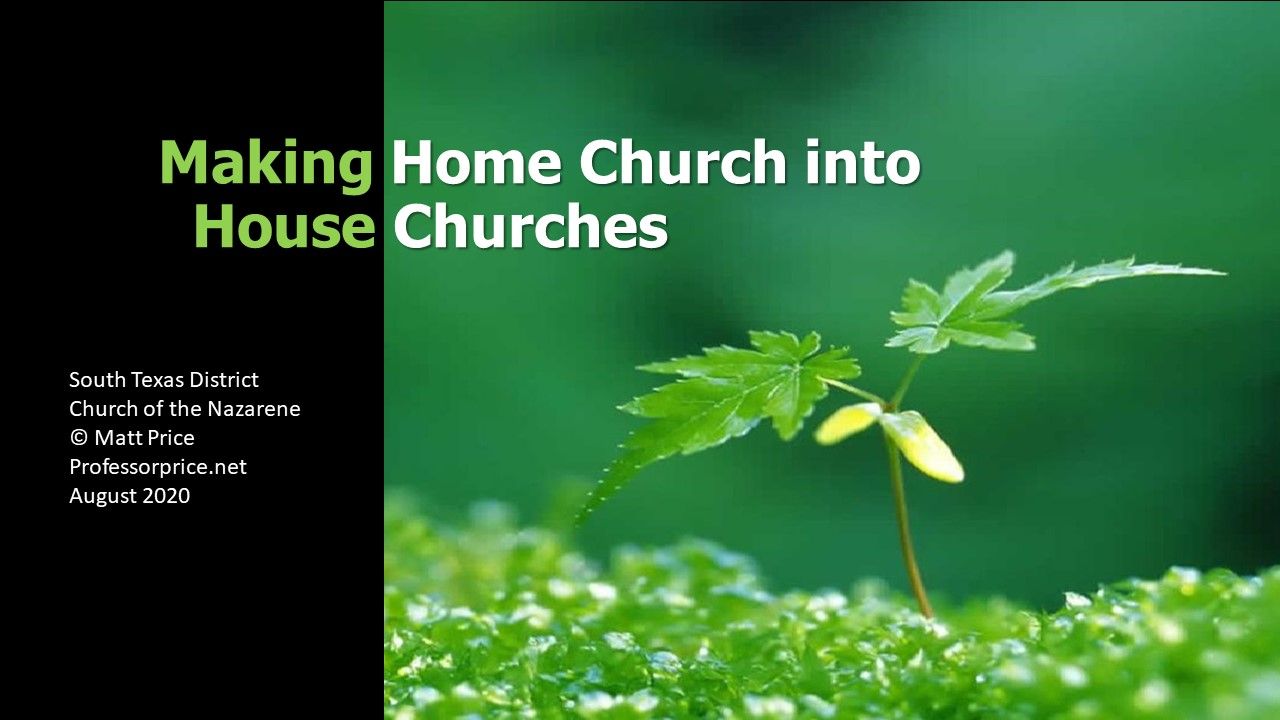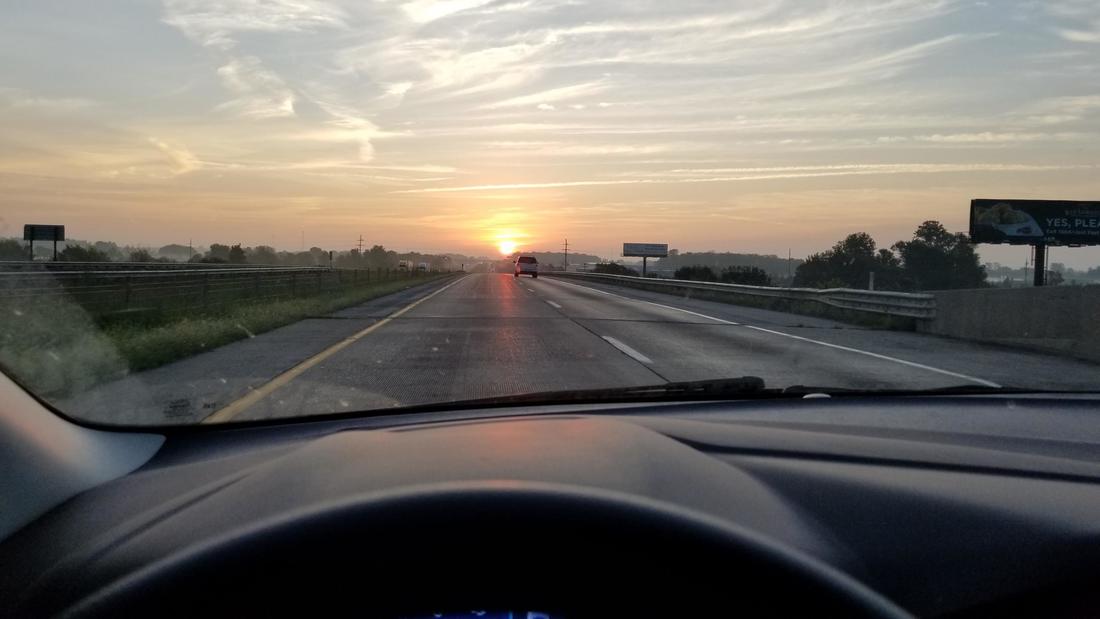|
The COVID-19 pandemic has made it difficult to for groups of people to gather. For the church, weekly worship gatherings have become nearly impossible or restricted by local guidelines. It is possible for the local church to be present in its context but it may require becoming a network of house churches. Here are links to a Powerpoint presentation and training video followed by a print version of the training material.  (Click image to download presentation slides) (Click image to download presentation slides) Church, Defined The church is still the church regardless of how it gathers. One definition of church is defined is: “Any group that meets regularly for spiritual nurture, worship, or instruction, with an identified leader and aligned with the message and mission of the Church of the Nazarene, may be recognized as a church and reported as such for district and general church statistics.” Board of General Superintendents, December 8, 2015 There are five minimum characteristics for a local church to be a church. “Any group that (1) meets regularly for (2) spiritual nurture, worship, or instruction, (3) with an identified leader and (4) aligned with the message and mission of the Church of the Nazarene, (5) may be recognized as a church and reported as such for district and general church statistics.” Let's compare a description of the New Testament church from the Book of Acts to the five characteristics of a local church: Acts 2:42-47 (NRSV) compared to BGS ruling 2015 42 They devoted themselves [meets regularly] to the apostles’ teaching [identified leader] and fellowship, to the breaking of bread and the prayers [spiritual nurture, worship, instruction]. 43 Awe came upon everyone, because many wonders and signs were being done by the apostles. [Identified leaders] 44 All who believed were together and had all things in common; 45 they would sell their possessions and goods and distribute the proceeds to all, as any had need. [aligned with the message and the mission] 46 Day by day, as they spent much time together in the temple, they broke bread at home and ate their food with glad and generous hearts, [recognized as a church] 47 praising God and having the goodwill of all the people. And day by day the Lord added to their number those who were being saved. [reported as such for district and general church statistics] (thanks to John DeMuth for thinking this through with me) There are right and wrong ways of meeting as house churches, according to church planter Steve Brenmer (2012). What house churches do right: Intimacy, accountability, offers freedom and flexibility, outward-focused (with an emphasis on reaching neighbors, and meets with intentionality (know why they are doing what they’re doing). What house churches do wrong: Still needs physical space to meet, turns inward-focused, no longer brings in new people, no longer makes disciples and just hangs out, becomes arrogant in that this smaller gathering is the only legitimate way to meet together as the church. How are house churches different than small groups? Small groups are focused on one thing: fellowship, Bible study, gender groups, or a service project. House Churches are focused on being the church: worshipping, learning, serving as an extension of the Body of believers gathered together Where should house churches meet? Geography - ZIP code, housing development, apartment complexes, direction from the gathered church Why geography? Same schools, same grocery stores, travel time, needs to be a focus on gathering for being the church not around lesser reasons, Keep the purpose in focus Why not affinity groups or groups of friends? See the point about house churches being inwardly focused. Rarely will this kind of group invite an outsider that isn’t already closely connected to someone in the group. This group also is so focused on the ancillary reason they are meeting together, such as a book club or women’s group, and not why they are meeting together as the church. Make the Body local. Find where the Body already is. Let the Church move into the neighborhood. Who meets in the house church? Around ten adults. Jewish synagogues require at least ten heads of household. The same applies here. A church of 50 might have two churches of 18 to 25 people or three groups of 15 to 18 people. Those involved in house church include: The designated (trained) leader appointed by the pastor/board as a lay preacher, the host family, children/youth activity volunteer, and any other guests. For COVID-19 precautions - Suggest no more than 10 persons at a time in a room or backyard gathering. Children might go right into a lesson time in a separate space rather than gather with the whole to limit numbers in a single space at one time. Masks recommended (and may be required by the host family). Remember that everyone is a guest. Household rules need to be honored by the guests When does a house church meet? Options include:
Suggested time frame is 90 minutes from arrival of guests to departure of the last family Example: 4:30 p.m. Arrive at the location 4:45 p.m. Begin the time together whether it is singing together or sharing praises with one another, including listening to the worship portion of morning’s service, listening/singing along with a Spotify playlist, etc.), lead by a single guitar or piano, no more than three songs 5:00 p.m. Announcements and allow children’s and youth activities to begin in other rooms 5:05 p.m. Listen to the sermon together. Feel free to pause for discussion 5:30 p.m. Pause for response, accountability, and prayer. Feel free to make smaller groups for prayer if space allows. 5:45 p.m. Gather for snacks, finger foods, and fellowship 6:00 p.m. Begin departing More COVID-19 precautions - Consider not serving food. Limit the gathering time to 45 minute to avoid the need for restroom usage.Also, singing may not be wise in a small, confined space. Other options include someone playing an instrumental or ensemble together, reciting a poem, memorizing and reading hymns together interspersed with prayer, Bible reading and reflection (e.g. lectio divina). How does the house church stay connected to the primary local church? The designated leaders are trained, accountable to, and appointed by the pastor and staff. A local church board might confer a local minister's license to each house church leader. Designated leaders report the meeting times in advance and accurately to the pastor and church staff for promotion on the web site or social media. House Church leaders also track and report participation in the house church. They are also responsible for giving prayer requests and concerns to the pastor and church staff. Offerings are best handled through online giving opportunities. If cash and checks are given, designated leaders are to bring to the pastor and/or church office the following day. Or, mobilize the finance team/board members to collect the offerings and bring to the church office for accounting and deposit. The pastor and/or church staff may distribute announcements (written copies or weblinks to online videos), as well as give leaders the weekly discussion questions for the sermon/teaching times, and share prayer requests. Host families may display a yard sign showing connection to the primary church with contact info, websites, and maybe leaflets with take-home information. Board members could be asked to host or attend the house church gathering nearest them. One or two board members could volunteer to visit multiple house church gatherings as a means of accountability. What makes this “count” as going to church? The BGS definition of church as gathering for “spiritual nurture, worship, or instruction” is consistent with the message and mission of the Church of the Nazarene whether the gathering is in a church building, in a house, or anywhere else. There will be three essential elements in every gathering (borrowing language from Neil Cole):
How can house churches still feel unified as to the local church?
1 Comment
|
Bio
teacher, writer, Archives
August 2022
Categories
All
|



 RSS Feed
RSS Feed